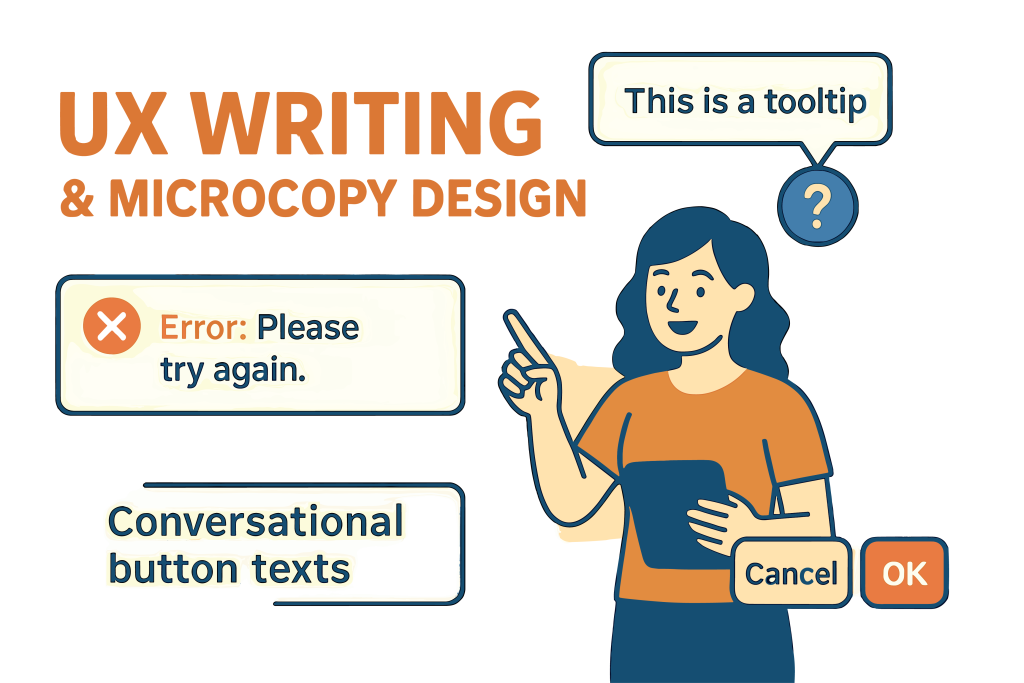
Introduction
Microcopy—the tiny bits of text that guide users through interfaces—often goes overlooked despite its outsized role in shaping user experience. From button labels and tooltips to error messages and confirmation dialogs, well-crafted microcopy can clarify intent, build trust, and drive conversions. Conversely, vague or confusing microcopy contributes to friction, user frustration, and abandoned workflows.
At NarraUX, the premier AI-powered UX writing course, we believe that mastering microcopy is the key to creating intuitive, human-centered digital products. Through gamified AI quests, our learners refine every snippet of interface text using real-time, data-driven feedback. This article dives into the psychology, principles, pitfalls, and AI enhancements of microcopy so you can start using small words to make a big UX impact.
1. The Psychology of Microcopy
1.1 Reducing Cognitive Load
Cognitive load theory tells us that human working memory has limited capacity. Every extra decision slows users down and increases mental effort. Microcopy that uses clear, jargon-free language helps strip away unnecessary complexity. For example, labeling a button “Start Free Trial” immediately conveys action, timeframe, and benefit—no guesswork.
1.2 Emotional Triggers and Tone of Voice
Beyond clarity, microcopy sets tone. Friendly, conversational copy can evoke positive emotions and build rapport. Consider the difference between:
> Form submission failed.
versus:
> Oops—looks like something went wrong. Want to try again?
The second version acknowledges the user’s frustration and offers reassurance, transforming a negative moment into a more empathetic experience.
1.3 Behavioral Nudges
Microcopy can steer user behavior with subtle prompts. Changing “Submit” to “Get your guide” frames an action as valuable and specific, improving click-through rates. Small lexical changes can produce big UX improvements backed by A/B test data.
2. Key Principles for Effective Microcopy
2.1 Clarity: Plain Language
- Use simple vocabulary and avoid industry jargon.
- Write in the active voice: “Upload your photo” vs. “Your photo can be uploaded.”
- Spell out consequences: “Delete account” vs. “Permanently delete your account and data.”
2.2 Brevity: Less is More
- Aim for maximum 3-5 words in button labels.
- Keep tooltips and helper texts under 12 words.
- Use sentence fragments when appropriate, as long as the meaning remains crystal clear.
2.3 Accessibility: Inclusive Language
Microcopy should account for screen readers, localization, and diverse audiences. Use gender-neutral pronouns, avoid idioms, and ensure text wraps correctly in different languages. Always test microcopy with assistive tools.
2.4 Actionability: Prompt Users
- Frame microcopy as guidance: “Enter your email to receive updates” vs. “Email address.”
- Provide next steps: “Need help? Visit our support center.”
- Use verbs that inspire action: “Explore courses,” “Share feedback,” “Claim offer.”
3. Common Microcopy Pitfalls & How to Avoid Them
3.1 Jargon and Buzzwords
Avoid terminology that only experts understand. Replace “synergy” with “teamwork,” “seamless integration” with “easily connect,” and so on.
3.2 Vague CTAs
Generic CTAs like “Submit” or “Continue” leave users wondering what happens next. Be explicit: “Submit feedback,” “Continue to checkout,” “See your dashboard.”
3.3 Overloaded Error Messages
Error copy should focus on cause and solution, not blame or technical details. Instead of:
> Error 404: File not found. Code: 0x8004F050.
Use:
> We couldn’t find that page. Check the URL or return home.
4. How AI Enhances Microcopy Creation
4.1 Real-Time Recommendations
With NarraUX’s AI Feedback Engine, learners get instant suggestions on tone, readability, and accessibility as they type. This accelerates the drafting process and reduces reliance on manual style guides.
4.2 A/B Test Simulation
Our AI can simulate A/B test outcomes by analyzing past performance data, helping you choose the microcopy variant with the highest engagement potential.
Conclusion & Next Steps
Microcopy may be small, but its impact on user experience is massive. By applying the principles of clarity, brevity, and accessibility—and leveraging AI-driven feedback—you can transform every bit of interface text into a conversion booster. Ready to elevate your microcopy skills? Enroll in NarraUX today, dive into our gamified AI quests, and start crafting microcopy that delights users and drives results.
